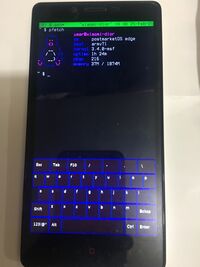Xiaomi Redmi Note 4G (xiaomi-dior): Difference between revisions
Fix capitalization of manufacturer |
→How to enter flash mode: Update Twrp URL |
||
| Line 60: | Line 60: | ||
== How to enter flash mode == | == How to enter flash mode == | ||
* Entering fastboot: hold {{Button|Volume Down}} + {{Button|Power}} buttons until fastboot mode is displayed on the screen. | * Entering fastboot: hold {{Button|Volume Down}} + {{Button|Power}} buttons until fastboot mode is displayed on the screen. | ||
* Entering recovery: hold {{Button|Volume Up}} + {{Button|Power}} buttons. The default is Mi Recovery. TWRP is needed for installation, which can be obtained [https://twrp.me/xiaomi/ | * Entering recovery: hold {{Button|Volume Up}} + {{Button|Power}} buttons. The default is Mi Recovery. TWRP is needed for installation, which can be obtained [https://twrp.me/xiaomi/xiaomiredminote4gsinglesim.html here] | ||
== Installation == | == Installation == | ||
Revision as of 07:39, 9 June 2022
 FbKeyboard and pfetch on Xiaomi-dior | |
| Manufacturer | Xiaomi |
|---|---|
| Name | Redmi Note 4G |
| Codename | xiaomi-dior |
| Released | 2014 |
| Hardware | |
| Chipset | Qualcomm MSM8928 Snapdragon 400 |
| CPU | Quad-core 1.6 GHz Cortex-A7 |
| GPU | Adreno 305 |
| Display | 720 x 1280 pIPS LCD |
| Storage | 8GB |
| Memory | 2GB |
| Architecture | armv7 |
| Software | |
| Original software | Android 4.2 |
| postmarketOS | |
| Category | testing |
| Pre-built images | no |
| Flashing |
Partial |
|---|---|
| USB Networking |
Works |
| Internal storage |
No data |
| SD card |
No data |
| Battery |
Partial |
| Screen |
Works |
| Touchscreen |
Works |
| Multimedia | |
| 3D Acceleration |
No data |
| Audio |
No data |
| Camera |
No data |
| Camera Flash |
No data |
| Connectivity | |
| WiFi |
Works |
| Bluetooth |
No data |
| GPS |
No data |
| NFC |
No data |
| Modem | |
| Calls |
No data |
| SMS |
No data |
| Mobile data |
No data |
| Miscellaneous | |
| FDE |
No data |
| USB OTG |
No data |
| HDMI/DP |
No data |
| Sensors | |
| Accelerometer |
No data |
| Magnetometer |
No data |
| Ambient Light |
No data |
| Proximity |
No data |
| Hall Effect |
No data |
| Haptics |
No data |
| Barometer |
No data |
Contributors
- Edwin0cheng
Maintainer(s)
Users owning this device
How to enter flash mode
- Entering fastboot: hold + buttons until fastboot mode is displayed on the screen.
- Entering recovery: hold + buttons. The default is Mi Recovery. TWRP is needed for installation, which can be obtained here
Installation
To flash this device, the boot partition have to be flashed by fastboot:
$ pmbootstrap export$ fastboot flash:raw boot /tmp/postmarketOS-export/boot.img-xiaomi-dior
However, rootfs could be flash by pmbootstrap normally:
$ pmbootstrap flasher flash_rootfs
And its system partition is quite small (800mb), to flash a large distribution (e.g. xfce4), you have to:
1. Split the boot and root partitions (hint: you can use pmbootstrap install --split instead of losetup tricks):
sudo losetup /dev/loop0 /tmp/postmarketOS-export/xiaomi-dior.img
sudo dd if=/dev/loop0p1 of=boot_partition.img
sudo dd if=/dev/loop0p2 of=root_partition.img
sudo losetup -d /dev/loop0
2. Flash the boot partition to system partition:
$ fastboot flash system boot_partition.img
3. Use the netcat method to flash to user partition:
https://gitlab.com/postmarketOS/pmbootstrap/-/issues/456
Additional info
This original implementation of framebuffer device do not support framebuffer console and X-Windows, we patched all missing pieces such that it works. So xfce4 and FbKeyboard works now.
However, due to lacking of DRM driver, all drm related UI are not workings.
See also
- pmaports!1992 Initial merge request